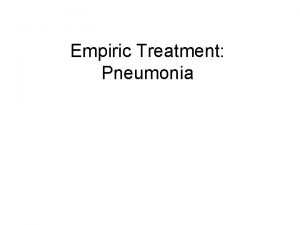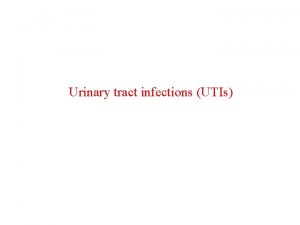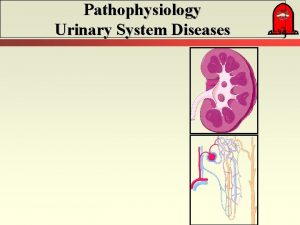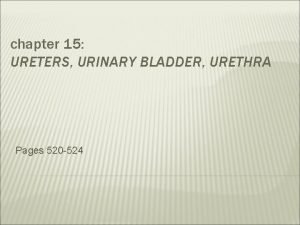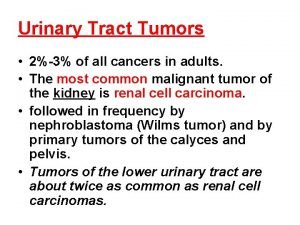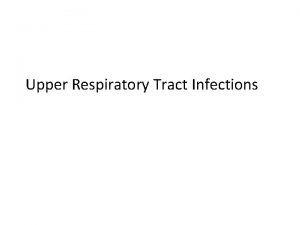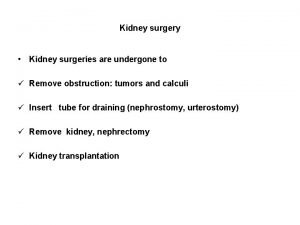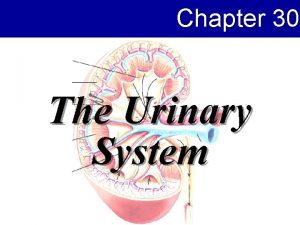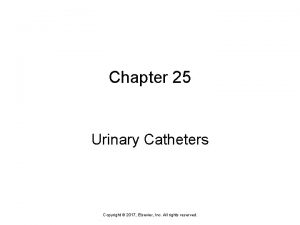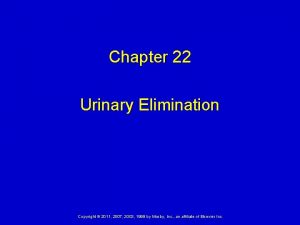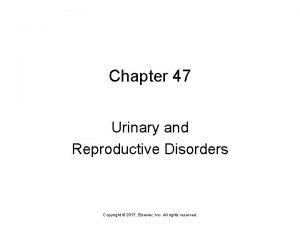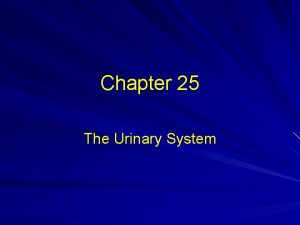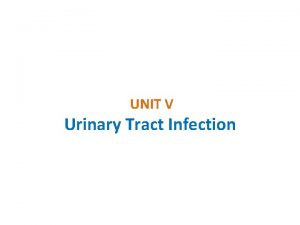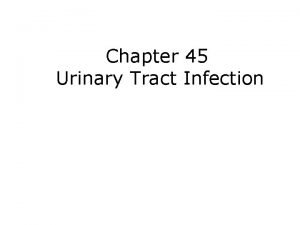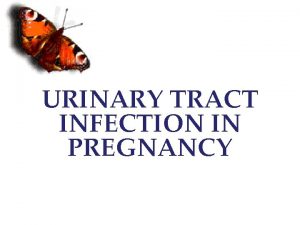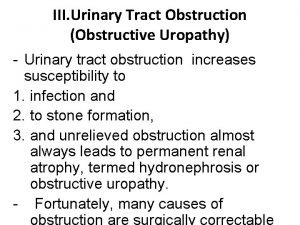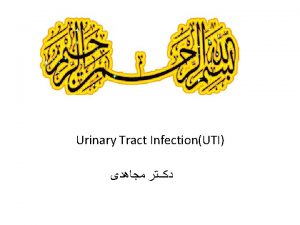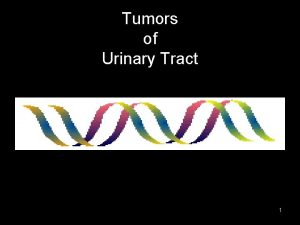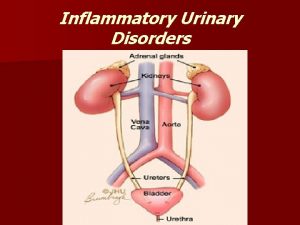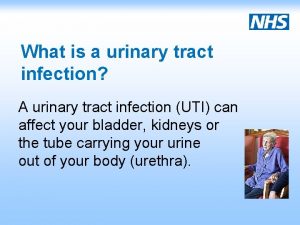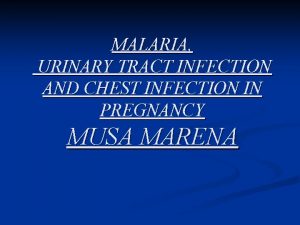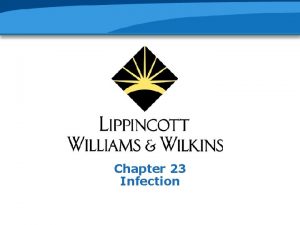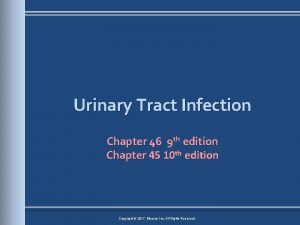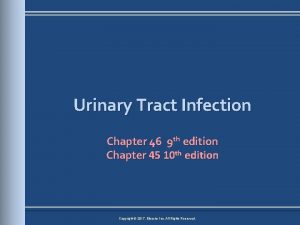Urinary Tract Infection relates to Chapter 44 Nursing









































- Slides: 41

Urinary Tract Infection (relates to Chapter 44, “Nursing Management: Renal and Urologic Problems, ” in the textbook)

Urinary Tract Infection Second most common bacterial disease l Account for more than 8 million office visits per year l Results in >100, 000 people hospitalized annually l

Urinary Tract Infection l >15% patients who develop gramnegative bacteria die – 1/3 of these caused by infections originating in urinary tract

Urinary Tract Infection Bladder and its contents are free of bacteria in majority of healthy patients l Minority of healthy individuals have colonizing bacteria in bladder – Called asymptomatic bacteriuria and does not justify treatment l

Urinary Tract Infection E. coli most common pathogen l Counts of 105 CFU/ml indicate significant UTI l Counts as low as 102 CFU/ml in a person with signs and symptoms are indicative l

Urinary Tract Infection Classification Upper tract involves renal parenchyma, pelvis, and ureters – Typically causes fever, chills, flank pain l Lower tract involves lower urinary tract – No usual systemic manifestations l

Urinary Tract Infection Classification Pyelonephritis is inflammation of renal parenchyma and collecting system l Cystitis is inflammation of bladder wall l Urethritis is inflammation of the urethra l

Urinary Tract Infection Classification l Uncomplicated infection occurs in otherwise normal urinary tract

Urinary Tract Infection Classification l Complicated infections occur with coexisting presence of – Obstruction – Stones – Catheters – Diabetes or neurologic disease – Recurrent infection

Urinary Tract Infection Classification Initial infection l Recurrent UTI l Unresolved bacteriuria l Bacteria persistence l

Urinary Tract Infection Etiology and Pathophysiology Physiologic and mechanical defense mechanisms maintain sterility l Alterations in defense mechanisms increase risk of infection l Organisms causing UTI usually introduced via ascending route from urethra l

Urinary Tract Infection Etiology and Pathophysiology Contributing factor: urologic instrumentation l Sexual intercourse promotes “milking” of bacteria from perineum and vagina l UTIs rarely result from hematogenous route l

Urinary Tract Infection Etiology and Pathophysiology Common source of hospital-acquired UTI is nosocomial infections l Urologic instrumentation common predisposing factor l

Urinary Tract Infection Clinical Manifestations l Symptoms – Dysuria – Frequent urination (>q 2 h) – Urgency – Suprapubic discomfort or pressure

Urinary Tract Infection Clinical Manifestations Urine may contain visible blood or sediment, giving cloudy appearance l Flank pain, chills, and fever indicate infection of upper tract (pyelonephritis) l

Urinary Tract Infection Clinical Manifestations in Older Adult Symptoms often absent l Experience non-localized abdominal discomfort rather than dysuria l May have cognitive impairment l Less likely to have a fever l

Urinary Tract Infection Clinical Manifestations Patients with significant bacteriuria may have no symptoms or nonspecific symptoms like fatigue or anorexia l Patients with bladder tumors or those receiving intravesical chemotherapy or pelvic radiation usually experience frequency, urgency, and dysuria l

Urinary Tract Infection Diagnostic Studies Initially obtain dipstick urinalysis to identify presence of nitrates, WBCs, and leukocyte esterase l Findings confirmed by microscopic urinalysis l Following confirmation of bacteriuria and pyuria, urine culture may be obtained l

Urinary Tract Infection Diagnostic Studies Urine culture indicated in complicated or nosocomial, persistent bacteria, or frequently recurring (>2 episodes annually) l May be cultured if infection is unresponsive to empiric therapy or diagnosis is questionable l

Urinary Tract Infection Diagnostic Studies Clean-catch is preferred l Specimen obtained by catheterization or suprapubic needle aspiration has more accurate results l

Urinary Tract Infection Diagnostic Studies Sensitivity testing determines susceptibility to antibiotics l Imaging studies are indicated in selected cases – IVP or abdominal CT when obstruction suspected l

Urinary Tract Infection Collaborative Care Drug Therapy Antibiotic selected on empiric therapy or results of sensitivity testing l Uncomplicated cystitis treated by shortterm course of antibiotics l Complicated UTIs require long-term treatment l

Urinary Tract Infection Collaborative Care Drug Therapy l Trimethoprim-sulfamethoxazole (TMPSMX) or nitrofurantoin used to treat empiric uncomplicated or initial – Inexpensive – TMP-SMX taken bid

Urinary Tract Infection Collaborative Care Drug Therapy Pyridium is OTC that provides soothing effect on urinary tract mucosa – Stains urine reddish orange that can be mistaken for blood and may stain underclothing l Effective in relieving discomfort l

Urinary Tract Infection Collaborative Care Drug Therapy l Combination agents (e. g. , Urised) used to relieve pain – Preparations with methylene blue tint urine blue or green

Urinary Tract Infection Collaborative Care Drug Therapy Prophylactic or suppressive antibiotics sometimes administered to patients with repeated UTIs l TMP-SMX administered qd to prevent recurrence or single dose prior to events likely to cause UTI l

Urinary Tract Infection Nursing Management Nursing Assessment l Health History-what will you ask? l Subjective Data- what symptoms might the client describe? l Objective Data- what signs might you find?

Urinary Tract Infection Nursing Management Nursing Diagnoses Acute pain l Impaired urinary elimination l

Urinary Tract Infection Nursing Management Planning Patient will have l Relief from lower urinary tract symptoms l Prevention of upper urinary tract involvement l Prevention of recurrence

Urinary Tract Infection Nursing Management Nursing Implementation l Health Promotion – Recognize individuals at risk

Urinary Tract Infection Nursing Management Nursing Implementation l Health Promotion – Emptying bladder regularly and completely – Evacuating bowel regularly – Wiping perineal area front to back – Drinking adequate fluids (15 ml per lb)

Urinary Tract Infection Nursing Management Nursing Implementation l Health Promotion – Daily intake of cranberry juice or cranberry essence may help reduce risk – Avoid unnecessary catheterization and early removal of indwelling catheters l Prevents nosocomial infections

Urinary Tract Infection Nursing Management Nursing Implementation l Health Promotion – Aseptic technique must be followed during instrumentation procedures – Wash hands before and after contact – Wear gloves for care of urinary system

Urinary Tract Infection Nursing Management Nursing Implementation l Health Promotion – Routine and thorough perineal care for all hospitalized patients – Avoid incontinent episodes by answering call light and offering bedpan at frequent intervals

Urinary Tract Infection Nursing Management Nursing Implementation l Acute Intervention – Adequate fluid intake l Patient may think will worsen condition due to discomfort l Dilutes urine, making bladder less irritable l Flushes out bacteria before they can colonize

Urinary Tract Infection Nursing Management Nursing Implementation l Acute Intervention – Avoid caffeine, alcohol, citrus juices, chocolate, and highly-spiced foods l Potential – bladder irritants Application of local heat to suprapubic or lower back may relieve discomfort

Urinary Tract Infection Nursing Management Nursing Implementation l Acute Intervention – Instruct patient about drug therapy and side effects – Emphasize taking full course despite disappearance of symptoms – Second or reduced drug may be ordered after initial course in susceptible patients

Urinary Tract Infection Nursing Management Nursing Implementation l Acute Intervention – Instruct patient to watch urine for changes in color and consistency and decrease in cessation of symptoms – Counsel on persistence of lower tract symptoms beyond treatment or onset of flank pain or fever should be reported immediately

Urinary Tract Infection Nursing Management Nursing Implementation l Ambulatory and Home Care – Emphasize compliance with drug regimen l Take – – – as ordered Maintain adequate fluids Regular voiding Void after intercourse

Urinary Tract Infection Nursing Management Nursing Implementation – – – Temporarily discontinue use of diaphragm Instruct on follow-up care with urine culture Recurrent symptoms typically occur in 12 weeks after therapy

Urinary Tract Infection Nursing Management Evaluation Use of nonanalgesic relief measures l Appropriate use of analgesics l Pass urine without urgency l Urine free of blood l Adequate intake of fluids l
 Nursing management for urinary tract infection
Nursing management for urinary tract infection Sterile pyuria ppt
Sterile pyuria ppt Complicated urinary tract infection
Complicated urinary tract infection Urinary tract infection in pregnancy ppt
Urinary tract infection in pregnancy ppt Renal lobe and lobule
Renal lobe and lobule Sexually transmitted diseases
Sexually transmitted diseases Urinary tract obstruction
Urinary tract obstruction Urethra
Urethra Tumor in the urinary tract
Tumor in the urinary tract Classification of upper respiratory tract infection
Classification of upper respiratory tract infection Lrti
Lrti Extrapyramidal vs pyramidal
Extrapyramidal vs pyramidal Olivospinal tract vs tectospinal tract
Olivospinal tract vs tectospinal tract Nursing management of urinary retention ppt
Nursing management of urinary retention ppt Glomerular filtration
Glomerular filtration Chapter 11 urinary system medical terminology
Chapter 11 urinary system medical terminology The urinary system chapter 30
The urinary system chapter 30 Chapter 22 urinary elimination
Chapter 22 urinary elimination Chapter 15 the urinary system figure 15-3
Chapter 15 the urinary system figure 15-3 Chapter 25 urinary catheters
Chapter 25 urinary catheters Chapter 24 urinary elimination
Chapter 24 urinary elimination Chapter 22 urinary elimination
Chapter 22 urinary elimination Chapter 20 urinary/excretory system
Chapter 20 urinary/excretory system The urinary system chapter 15
The urinary system chapter 15 Chapter 9 the urinary system learning exercises answer key
Chapter 9 the urinary system learning exercises answer key Chapter 47 urinary and reproductive disorders
Chapter 47 urinary and reproductive disorders The urinary system consists of
The urinary system consists of What gas law relates pressure and temperature
What gas law relates pressure and temperature Chapter 13 gases
Chapter 13 gases Green theorem is the relation between
Green theorem is the relation between Fick's law of diffusion formula
Fick's law of diffusion formula What formula relates moles, mass and mr?
What formula relates moles, mass and mr? Hooke's law relates
Hooke's law relates If vince charged $200
If vince charged $200 Which of the 4 ps relates to packaging?
Which of the 4 ps relates to packaging? The formula c=5p+215 relates c
The formula c=5p+215 relates c Consolidation entry asterisk c relates to
Consolidation entry asterisk c relates to Vaidyanathan committee report relates to revival of
Vaidyanathan committee report relates to revival of Variation in mathematics
Variation in mathematics Universal affirmative
Universal affirmative Chapter 19 disease transmission and infection prevention
Chapter 19 disease transmission and infection prevention Chapter 19 disease transmission and infection prevention
Chapter 19 disease transmission and infection prevention


